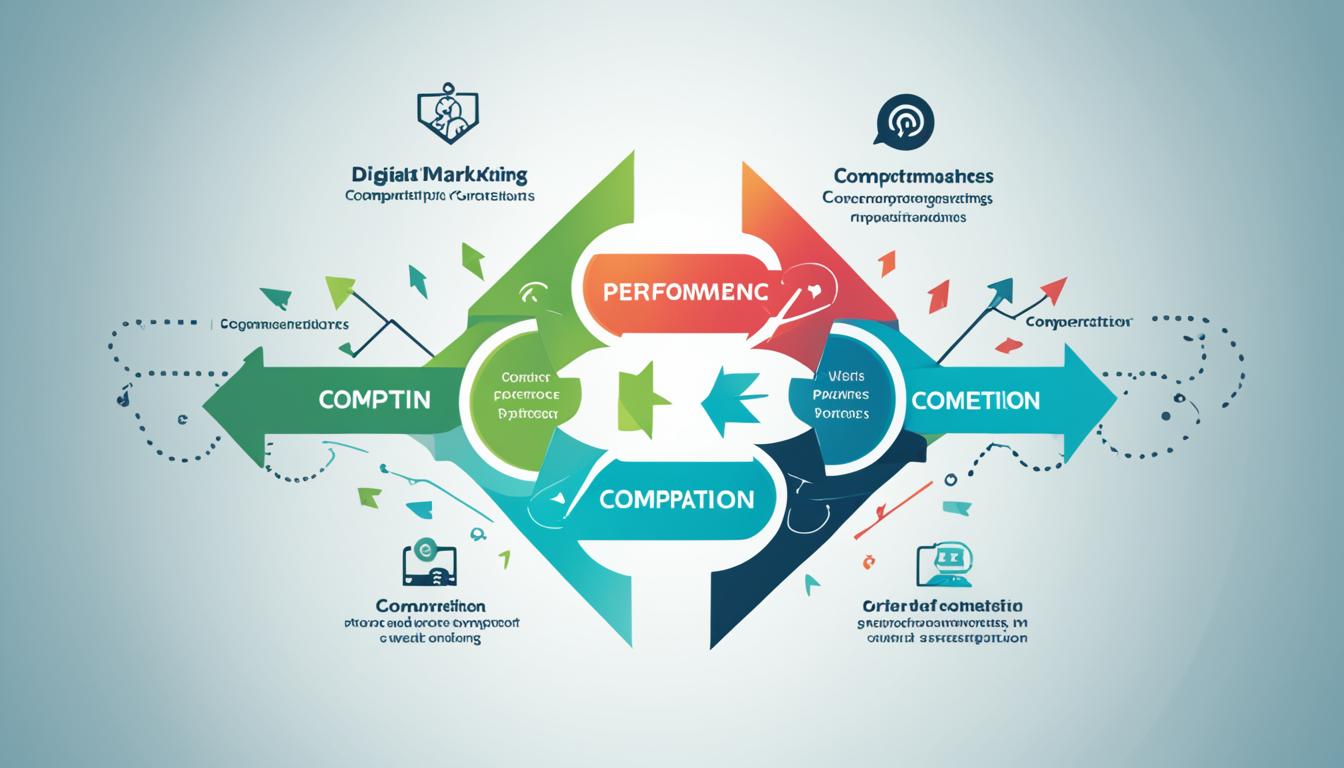Remarketing Lists for Search Ads, or RLSA, is a tool in Google Ads that helps advertisers. It lets them adjust their campaigns to target people based on their previous actions on a website. This means you can customize bids and tailor ad groups for those who have already shown interest.
In this guide, we will explore the advantages of RLSA. We’ll also share tips on making your RLSA campaigns more effective.
Key Takeaways:
- RLSA allows advertisers to customize their search campaigns based on the past behavior of website visitors.
- By targeting users who have already interacted with the website, RLSA can optimize ad spend and increase conversion rates.
- RLSAs differ from traditional remarketing campaigns as they are designed specifically for the Google search network.
- To set up RLSAs, advertisers need to add the Google Ads tag to their website and create remarketing lists based on user behavior.
- Best practices for RLSA include audience segmentation, customized ad text, and regular optimization.
What are Remarketing Lists for Search Ads (RLSAs)?
Remarketing Lists for Search Ads, or RLSAs, are lists of people who visited your website before. They let advertisers show these visitors customized search ads. This method helps in targeting ads more precisely, leading to more conversions and better ROI.
With RLSAs, advertisers can set up special ad groups. These groups only show ads to people on the remarketing list, aiming at a more specific audience. This way, ads are shown to users more likely to be interested, thanks to their past site activities.
Advantages of RLSAs:
- Higher conversion rates: RLSAs target users already interested in the site, boosting the chances of them coming back to make a purchase.
- Improved ROI: These ads focus on those more likely to buy, making ad spending more efficient and improving returns.
- Precise audience targeting: RLSAs help reach particular visitor segments with ads that match their past interests and actions.
- Personalized messaging: The ads can be customized based on what visitors did on the site, making them more engaging.
RLSAs offer a great way for advertisers to enhance their search campaigns. They help reach out to people who already showed interest in your site. This strategy can significantly increase conversions, better ROI, and provide ads that resonate more with your audience.
How are RLSAs Different from Other Remarketing Campaigns?
Remarketing Lists for Search Ads (RLSAs) offer a special way to reconnect with users. Unlike traditional remarketing, which uses the Google Display Network, RLSAs target users on the Google search network.
RLSAs only show ads to people searching on Google. This means they can reach users who are already interested in what they are looking for. It’s a way to connect with users who are ready to act.
Using RLSAs can lead to spending your budget more wisely. They focus on users who have visited your website before. This reduces the chance of showing ads to those who are not interested. RLSAs ensure your ads are seen by people more likely to take action.
It’s important to understand how RLSAs differ from traditional remarketing. They make use of the Google search network to find users ready to make a purchase or learn more.
Comparison of RLSAs and Traditional Remarketing Campaigns
| Feature | RLSAs | Traditional Remarketing Campaigns |
|---|---|---|
| Platform | Google search network | Google Display Network |
| Reach | Users actively searching on Google | Users across various websites in the network |
| Intent | High intent as users actively seeking information | Varies based on website placements |
| Cost-effectiveness | Targeted approach reduces wasted ad spend | Potential for less targeted impressions |
When Should You Use RLSA?
Remarketing Lists for Search Ads (RLSAs) can boost your digital ad strategy. They help you target users who’ve visited your website before. These users are more likely to buy from you.
RLSAs let you show ads to certain parts of your audience. This means you can make your ads more personal. This helps build a stronger bond with people who know your brand.
RLSAs can also help you get more sales. By looking at how users acted on your site before, you can improve your ads. You can change your bids, what your ads say, and the pages they link to. This makes your ads more effective.
RLSAs offer many ways to up your ad game. Whether it’s targeting past visitors, customizing your campaigns, or getting more sales, RLSAs can help. By using this tool, you can make your digital ads work harder for your business.
Example:
Say you sell sports gear online. You see that many visitors look around but don’t buy anything. You can set up an RLSA campaign for these folks. Show them ads for the products they were interested in. This can make them want to come back and buy something.
Benefits of Using RLSAs
| Benefit | Description |
|---|---|
| Targeting Users Likely to Convert | Reach users who have already shown interest in your website, increasing the likelihood of conversions. |
| Audience Segmentation | Create customized ad campaigns for specific segments of your website visitors, delivering more personalized and relevant ads. |
| Conversion Optimization | Analyze user behavior to fine-tune your search campaigns and optimize for better conversion rates. |
How Do RLSAs Help Your PPC Campaign?
Remarketing Lists for Search Ads (RLSAs) boost your PPC campaign’s performance. They target users who already like your website, leading to better conversion rates and ROI. People familiar with your brand are more likely to buy, giving you a bigger return.
RLSAs allow for precise targeting. You can reach users who’ve seen your site before. This means you can make ads that truly matter to them. Ads that match their interests get more clicks.
Also, RLSAs let you create custom messages for your audience. You can make ads that speak to their past interactions with your site. This personal touch improves their experience and your conversion rates.
Using RLSAs can bring great advantages to your PPC efforts. They help convert interested users into customers, boosting your investment’s return. Tailored ads make your campaign more effective, leading to better outcomes.
How Do You Set Up RLSAs?
Setting up Remarketing Lists for Search Ads (RLSAs) involves a few key steps. These steps are crucial for effective audience targeting and remarketing campaigns. Let’s go over what you need to do:
Step 1: Add the Google Ads Tag
The first thing you’ll need to do is add the Google Ads tag to your site. This tag is a code snippet provided by Google. It should be placed on every page of your website. By adding this tag, Google can track user behavior and collect data. This data is used for creating remarketing lists.
Step 2: Create Remarketing Lists
With the Google Ads tag added, you can now start building remarketing lists. Create these lists based on how visitors interact with your site. For example, focus on behaviors like visiting product pages, leaving items in a cart, or signing up for newsletters. Making targeted remarketing lists is key for better audience targeting in your search campaigns.
Step 3: Define Audience Targeting
After making your remarketing lists, it’s time to use RLSAs to refine your search campaigns. In your RLSA campaign setup, you have the opportunity to adjust bids for people on your lists. You can offer higher bids for users who are more likely to make a purchase. This helps grab their attention again and increases your conversion chances.
Step 4: Implement RLSA in Search Campaigns
Now, with your remarketing lists and targeting ready, implement RLSA in your search campaigns. Create ad groups that target only users on your remarketing lists. This allows for more relevant and personal ads aimed at your key audience. Such customization boosts the impact of your RLSA campaigns.
By sticking to these steps, you can make the most of audience targeting. You’ll enhance your search campaigns and achieve better results with RLSAs.
RLSA Best Practices
Remarketing Lists for Search Ads (RLSAs) improve your campaign’s performance. Use these strategies to get the most from RLSAs:
- Audience Segmentation: Divide your audience by their past actions, likes, or demographics. This helps send targeted messages and adjust your bids right. Knowing your audience lets you make ads that meet their specific needs.
- Ad Text Customization: Change your ad text to fit what your audience does or likes. This makes your ads more relevant and appealing. Making ads personal is key to grabbing the attention of people interested in what you offer.
- Broad Term Bidding: Bid on broader terms for those already in your remarketing list. This approach helps you find more people and increase sales. By targeting wide, you can reach folks at different buying stages, drawing more traffic to your site.
- Upselling to Converted Users: Also, try selling more to people who’ve already bought from you. Show them additional products or new features to encourage another purchase. RLSAs are great for this, as you know what these customers like.
Example of RLSA Best Practices:
To make your RLSA campaigns work better, use these tips. Always check how your campaign is doing. Try new ideas and adjust your approach based on what you learn.
RLSA Optimization Techniques
To make your Remarketing Lists for Search Ads (RLSA) campaigns work better, you should regularly check, analyze, and make smart changes. Here are some ways to boost your RLSA campaigns:
Analyze Conversion Tracking Data
Conversion tracking is very important for RLSA optimization. It lets you see how well your RLSA campaigns are working by tracking what users do after seeing your ads. By looking at conversion data, you can figure out which strategies get the most conversions and use this information to improve your campaigns.
Utilize Website Behavior Analysis
Knowing how users act on your website helps a lot in optimizing RLSA campaigns. By studying data like page views, time spent on the site, and actions taken, you get insights into what users like and do. This helps you make your targeting more accurate, your ads more appealing, and your campaigns more relevant.
For instance, finding that visitors to certain product pages are more likely to buy can lead you to market specifically to those users. You can tailor your ads to highlight the benefits of those products.
Regularly Test and Experiment
It’s important to try out different RLSA strategies to find what’s best for your audience. Test various audience groups, ad styles, ad texts, and how much you bid. A/B testing lets you see which options perform better, helping you make decisions based on real data.
Example of RLSA Optimization Techniques
| RLSA Optimization Technique | Benefits |
|---|---|
| Analyze conversion tracking data | Measure the effectiveness of RLSAs and make data-driven optimizations |
| Utilize website behavior analysis | Gain insights into user preferences and improve targeting |
| Regularly test and experiment | Refine campaigns and maximize results |
Using these optimization methods will make your RLSA campaigns better. This leads to more conversions and a stronger return on investment. Always keep an eye on performance data, adjust your strategies based on what users do, and continue to try new things to beat the competition.
Remarketing Lists for Search Ads Examples
Remarketing Lists for Search Ads (RLSAs) offer many ways for precise ad targeting. Here’s how you can use RLSAs:
- Show ads to visitors of specific website pages: By making lists from user actions, like viewing product pages or cart interaction, you can aim ads at these users for related searches.
- Make the most of a small ad budget: With RLSAs, focus your spending on users who’ve shown interest in your site. This method increases your ad impact and boosts conversion chances.
- Use generic terms for ready-to-buy users: When you mix RLSAs and general search terms, you get cost-effective, quality leads. By leaving out current customers, you can attract new ones more efficiently.
- Customize ads and pages for known visitors: Crafting personalized ads and pages for past visitors can push them to convert. This approach enhances remarketing effectiveness.
These examples show RLSAs’ flexibility and their role in successful ad targeting. Through smart remarketing and RLSAs, businesses can fine-tune ads and connect with their audience effectively.
Benefits of RLSAs
Remarketing Lists for Search Ads (RLSAs) bring many perks to the table for advertisers. They help use ad money more wisely, make more sales, and get better returns. By focusing on people who have already visited the website, RLSAs make ads more targeted and engaging.
1. Ad Spend Optimization
RLSAs let advertisers save money by aiming at users with a known interest in their site. This way, they spend their budget on those more likely to buy. It makes ad campaigns more effective and saves money.
2. Increased Conversion Rates
Targeting users who know the site means RLSAs raise the chances of them acting. Familiar users are more willing to purchase or sign up. Advertisers can thus craft messages that hit the mark, raising sales chances.
3. Enhanced User Experience and Engagement
With RLSAs, ads and website pages can be customized for return visitors. This personal touch makes users happier and more involved. People react better to ads that match their past site actions. This means more clicks and engagement.
| Without RLSAs | With RLSAs | |
|---|---|---|
| Ad Spend | Spreads across all users, including new visitors | Targeted towards users who have already interacted with the website |
| Conversion Rates | Influenced by a broader audience | Increased by focusing on users who are more likely to convert |
| User Experience | Generic messaging for all users | Personalized messaging for users based on their past interactions |
The table above makes it clear: RLSAs outperform standard search efforts. They save ad money, bump up sales, and make user experiences better.
RLSAs are essential for advertisers wanting more from their search campaigns. They stretch ad dollars further, improve sales, and offer a tailored experience. This leads to superior results and ROI.
Challenges and Limitations of RLSAs
Remarketing Lists for Search Ads (RLSAs) have many benefits. Yet, there are challenges and limitations too. These issues can affect how well RLSA campaigns work. It’s vital to tackle these challenges wisely to get the most out of RLSAs.
Audience Size:
One downside of RLSAs is their need for a big remarketing audience. To work well, RLSAs need a certain number of visitors to your site. For websites with few visitors, RLSAs might not be very useful. Make sure your site gets enough traffic. This will help create big enough remarketing lists for RLSA campaigns.
Privacy Concerns:
Privacy worries and rules can also affect RLSAs. As the focus on protecting user data grows, it’s critical for advertisers to follow these rules. They must be open about how they collect and use data. Being transparent and providing clear information about remarketing practices can help deal with these privacy issues.
Remarketing Limitations:
RLSAs can only show ads to people who search on Google. They cannot use the Google Display Network like other remarketing campaigns can. This means advertisers might not reach as many people as they’d like. They could miss the chance to connect with a wider audience through display ads.
How to Overcome RLSA challenges
To beat the challenges of RLSAs, advertisers can take several steps:
- Work on getting more website traffic to grow your remarketing audience.
- Stay compliant with privacy laws by being open about how you collect and use data.
- Use other remarketing strategies, like traditional display remarketing, to connect with more people.
By tackling these challenges and using RLSAs’ strengths, advertisers can make their remarketing more impactful. This can lead to more effective and focused ad campaigns.
Conclusion
Remarketing Lists for Search Ads (RLSAs) are a key way to boost your Google Ads strategy. They let you target people who’ve visited your site before. This means you can really focus your ads on folks likely to be interested in what you’re offering. It’s a smart way to up your chances of making a sale and get more from your ad budget.
RLSAs offer a great chance to spike your conversion rates. Since you’re targeting past visitors, you can personalize your ads. This makes people more likely to buy. Plus, RLSAs help you spend your ad budget more wisely by targeting the right people at the perfect time.
To make the most of RLSAs, you need to get your audience segments and ads just right. Break down your audience based on their actions on your site. Then, tailor your ads to match what they’ve shown interest in before. Always be looking to fine-tune your strategies by tracking how well they’re doing and trying out new approaches.
Using RLSAs smartly can really change the game for your digital marketing efforts. They let you reach out again to people who’ve already shown interest in your site. This helps increase sales, use your ad budget effectively, and boost your overall ROI. Folding RLSAs into your bigger digital marketing plan can level up your remarketing and help you hit your ad targets.






